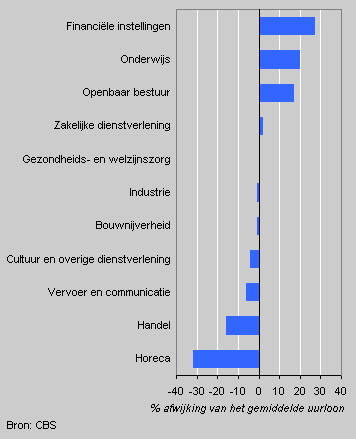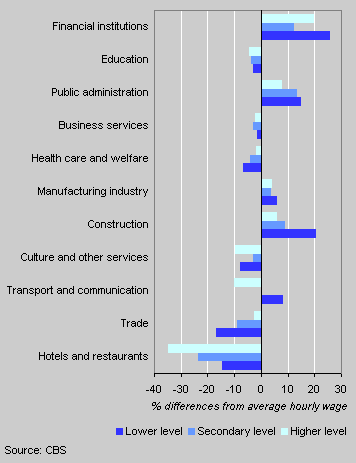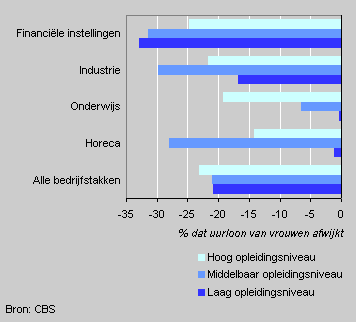Employees financial institutions well-paid

There are considerable differences between the hourly wage rates in the various sectors of industry. The average hourly wage was 17.24 euro at the end of 2002 but wages of employees of financial institutions were almost 30 percent higher. In education and public administration wages were nearly 20 percent above the average hourly wage rate. At the bottom of the list were wages earned by employees in the sector hotels and restaurants. Their wages were more than 30 percent below average, followed by wages of employees in the trade sector which were more than 15 percent down on the average hourly wage rate. Wage differences are closely linked to the level of education.
Differences by sector from the average hourly wage rate at the end of 2002

High education pays off
Hourly wages keep pace with the level of education. Lower educated employees earned on average 13.05 euro per hour. Employees at secondary education level earned 16.05 euro per hour and higher educated employees averaged 23.56 euro per hour.
Wages keep pace with education level
Even if the level of education is taken into account the wages paid by employers in the sector financial institutions are well above average. Wages earned by higher educated employees of financial institutions were 20 percent above the average for higher educated employees in general. The same applies to lower educated employees of financial institutions whose wages were no less than 25 up on lower educated employees across the board.
Employees in public administration, manufacturing industry and construction at all levels of education were also relatively well-paid. The sector hotels and restaurants pays the lowest wages. Higher educated employees in this sector were 35 percent down on the average wage rate, the lower educated were almost 15 percent below the average level.
Differences from the average hourly wage rate by sector and level of education at the end of 2002

Sector education has many higher educated employees
In the sector education approximately three-quarters of staff consist of higher educated employees. If the level of education is taken into account, employees in this sector are underpaid. To a lesser extent, this also applies to the sectors business services and health care and welfare.
A reversed trend is observed in manufacturing industry and construction where hourly wage rates for all employees were somewhat below average but hourly wages for individual education levels were above average. These sectors employ a relatively high amount of lower educated personnel.
Part-time jobs have marginal effect
In general, full-time jobs are better paid than part-time jobs. Information on the average hourly wage rate per sector includes part-time as well as full-time jobs. Roughly the same pattern of wage differences can be observed if part-time jobs are left out of account.
Differences in hourly wage rates between men and women by sector at the end of 2002

Women frequently underpaid by financial institutions
The wage gap between men and women is prominent in the sector financial institutions. Lower and secondary educated women earned over 30 percent less than their male counterparts. In manufacturing industry and the hotels and restaurants sector women educated at secondary level are relatively underpaid.
José Gouweleeuw and Wilmie Weltens